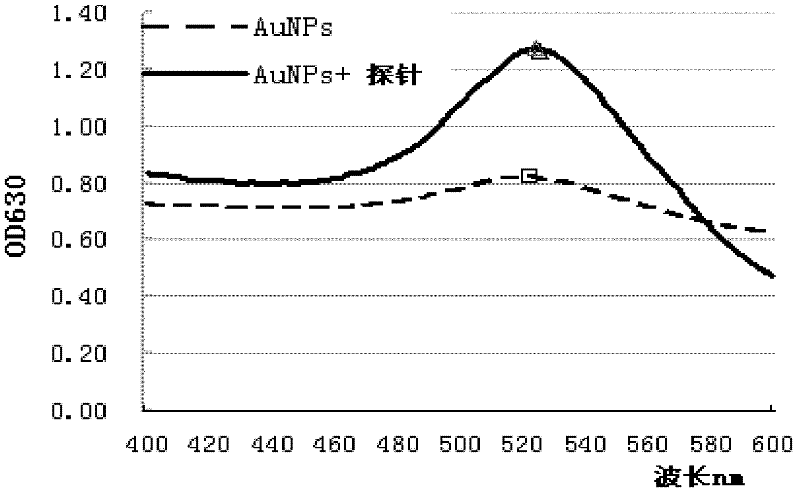Nanometer immunogold labeling probe for detecting peste des petits ruminants virus (PPRV) and detection kit
A PPR and probe technology, applied in the field of molecular biology, can solve the problems of false positives, limited resolution, primer-dimer interference, etc., and achieve the effects of simple operation, good repeatability and high sensitivity
- Summary
- Abstract
- Description
- Claims
- Application Information
AI Technical Summary
Problems solved by technology
Method used
Image
Examples
Embodiment 1
[0059] Embodiment 1 detects the determination of the PPRV target sequence, the design and synthesis of primers and probes
[0060] Refer to the gene sequences of PPRV Nigeria75 / 1 (GenBank: X74443.2) and other strains (HQ197753.1, EU267274.1, AJ849636.2, FJ905304.1, AJ563705.1) published by NCBI, which are conserved in the PPRV N gene The target nucleic acid fragment for detection of Peste des Petits Ruminants virus was found in the region, and its nucleotide sequence is shown in SEQ ID NO.1. Design specific primers to amplify it according to the target sequence:
[0061] PPRV-N115F: 5'-TCATATTTTGACCCGGCCTATTTCC-3' (SEQ ID NO. 2), PPRV-N115R: 5'-GTTTGGCTTCCTCTGCTGTGATAC-3'
[0062] (SEQ ID NO. 3).
[0063] Two specific probe sequences: P1-B: 5′-Biotin-CTCGGACAGGAGATGGT CAGAAGAT-3′ (SEQ ID NO.4), P2-G: 5′-GGTCAGCTCTGTAATC GCGGC(A)10SH-3′ (SEQ ID NO. .5).
[0064] Extract the total RNA of the PPR virus, reverse transcription PCR to obtain a 115bp fragment of the highly conser...
Embodiment 2
[0065] The preparation of embodiment 2 nano-gold labeled nucleic acid probes
[0066] 1. Preparation and characterization of gold nanoparticles
[0067] According to the method of Zhao Lifan et al. (Zhao Lifan, Li Baisheng, Hei Xiaohan, et al. Silver-stained enhanced nano-gold probe technology for detecting trace amounts of nucleic acid. Chinese Journal of Biochemistry and Molecular Biology. 2006 (11): 919-923.), prepare Nano gold solution with particle diameter of 13-15nm. Store at 4°C protected from light. The morphology and size of gold nanoparticles were observed by transmission electron microscope (accelerating voltage 120KV). According to Georganopoulou et al. (Georganopoulou, D.G., Chang, L., Nam, J.M., et al. Nanoparticle-based detection in cerebral spinal fluid of a soluble pathogenic biomarker for Alzheimer's disease.Proc Natl Acad Sci USA.2005, 102( 7): 2273-2276.) The method reported to calculate the concentration of nano gold solution. by the formula
[0068]...
Embodiment 3
[0075] Example 3 Establishment of Nano-gold Labeled Nucleic Acid Probe Detection Method for Peste des Petits Ruminants Virus
[0076] 1. Hybridization reaction
[0077] Take 10 μl of 1 nmol / L target nucleic acid solution prepared in Example 1, add 20 μl of hybridization buffer (buffer composition is 20 mmol / LPB, 0.3 mol / L NaCl, 0.01% SDS), denature at 95 ° C for 5 min, and place on ice for 5 min . Add 20 μl 100nmol / L biotinylated probe P1-B, the sequence is
[0078] P1-B: 5′-Biotin-CTCGGACAGGAGATGGTCAGAAGAT-3′, react at 42°C for 15 minutes. Next, 10 μl of the nano-gold nucleic acid probe prepared in Example 2 was added, and incubated at 42° C. for 15 minutes. The hybridization product was added to a streptavidin-coated microtiter plate (10 μg / ml streptavidin, 100 μl per well was coated). Place in a humid box and incubate at 37°C for 30min. Wash 3 times with PBST and pat dry. Add 100 μl silver staining solution (1% (w / v) gelatin: 0.52mol / L hydroquinone: pH 3.5 citrate buf...
PUM
| Property | Measurement | Unit |
|---|---|---|
| diameter | aaaaa | aaaaa |
| diameter | aaaaa | aaaaa |
Abstract
Description
Claims
Application Information
 Login to View More
Login to View More - R&D
- Intellectual Property
- Life Sciences
- Materials
- Tech Scout
- Unparalleled Data Quality
- Higher Quality Content
- 60% Fewer Hallucinations
Browse by: Latest US Patents, China's latest patents, Technical Efficacy Thesaurus, Application Domain, Technology Topic, Popular Technical Reports.
© 2025 PatSnap. All rights reserved.Legal|Privacy policy|Modern Slavery Act Transparency Statement|Sitemap|About US| Contact US: help@patsnap.com



